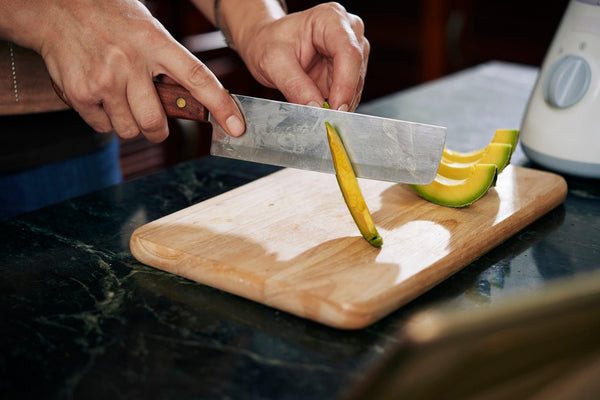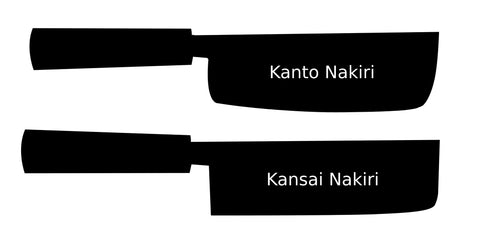
Jump to:
What Is a Nakiri Knife?
The nakiri knife is a traditional Japanese knife developed around the Edo period. It’s a single-purpose knife, only for cutting vegetables, so it’s often called a Japanese vegetable knife. It’s similar in shape to a Chinese cleaver, but slightly narrower. The blade is large, broad, and rectangular, and the edge of the blade is straight and flat, allowing the entire edge to touch the cutting board at the end of the cut. Its design is perfect for making clean, uniform cuts through tough vegetables.
The first records of the nakiri in Japan are from the early Edo period, which began in 1603. Edo was a time of unity across Japan following the Sengoku (warring states) period. During the Sengoku period records were sparse and disjointed, so it’s possible that nakiri existed prior to Edo without record.

There are two styles of nakiri knives in Japan, the Kansai style (western Japan) and the Kanto style (eastern Japan). As the nakiri knife was developed when people still traveled by foot or on horseback, the 500 kilometer distance between Tokyo and Osaka caused the knife to develop slightly differently in each region.
The Kansai style nakiri knife is square at the heel of the blade and has less of a curve at the front tip. While the Kanto style has a strong curve on both the heel and the tip, as well as a slightly more curved blade. These days, Kanto style nakiri knives are rarely seen, and most of the nakiri for sale are Kansai style. As Osaka is considered “the kitchen of Japan”, it makes sense that food and cooking products developed in Kansai eventually become the national standard. They both behave quite similarly, so there’s no answer to which is the best nakiri knife style, you should just choose whichever one you prefer.
What Is a Japanese Vegetable Knife?
The Japanese vegetable knife is one of the most important knives for chefs in Japan. Japanese cuisine is known for its fresh seafood and high-quality beef, but vegetables make up a huge part of the Japanese diet. So having a dedicated knife designed to cut only vegetables makes sense. Vegetable knives also allow chefs to do some pretty cool things, like the katsuramuki cutting technique that we’ll cover in the next section.
Apprentice chefs in Japan spend months practicing how to use a vegetable knife before they’re allowed to learn how to cut seafood or beef. Some even buy vegetables with their own money to practice at home. Cutting vegetables is a core skill for Japanese chefs, because without them as decoration or garnish, sashimi would just be raw fish on a plate.

There are two different vegetable knives, and they’re quite similar. They are the nakiri and the usuba. Nakiri (菜切) translates to “cut vegetables” and usuba (薄刃) translates to “thin blade”. Both knives have thin blades and cut vegetables, so their names might be confusing. It makes sense, however, as the usuba blade is significantly thinner than the nakiri blade. It can be thinner because it’s single-bevel. Single bevel blades are sharpened only on one side, often with a concave on the other. Double bevel blades are sharpened on both sides, in a “V” shape.
The single bevel usuba knife is very thin, which makes it light, and gives it unrivaled sharpness. It also makes it weak and brittle, and quick to lose its edge. Double bevel nakiri are a little less sharp, but they’re strong and durable. It takes a lot more to chip or damage a double bevel Japanese knife blade, and they hold their edge a lot longer - especially if they’re made of stainless steel.
Usuba knives require much more care and maintenance than nakiri knives, but there’s not much benefit for amateurs. If you’re a home cook or an amateur chef, you’re probably not going to see any difference if you use a nakiri knife. Even if you are a professional chef, whether you use a nakiri or an usuba, the result would be the same most of the time. However, if you cut very fine julienne, or shave vegetables to less than 1mm thick, using an usuba might be worth the extra hassle. If you'd like to learn more about Usuba, or any other Japanese knives, check out our guide to the 14 main types of Japanese kitchen knives.
What Is a Nakiri Knife Used For?
Peeling (katsuramuki)

Katsuramuki is the first cutting technique that apprentice chefs learn. The purpose is to peel paper-thin strips of vegetables using only a knife. Katsuramuki is most-often done with daikon radish. Chefs take a piece of daikon in one hand, and their nakiri or usuba vegetable knife in the other. They place the blade on the daikon, and rotate it while making up and down strokes with their knife. The daikon should be thin enough that you can see your knife through it, and you should be able to cut long strips without it breaking. Until apprentice chefs master this technique, they’re unable to move on to seafood and meat.

This technique is extremely important for sushi chefs. The sheets of daikon are stacked up high, and cut into very narrow strips, resulting in thin strings of raw daikon called ken or tsuma. The daikon strings are placed underneath sashimi as a garnish, and many sushi chefs consider them just as important as the fish.
Julienne (sengiri)

Sengiri is the Japanese style of julienning vegetables. The Japanese nakiri knife is ideal for sengiri as its flat blade can cut the entire vegetable at once, and make complete contact with the board at the bottom of the cut. This creates perfectly uniform cuts. Japanese chefs first peel the vegetable, such as a carrot, before cutting it into 5-10 cm pieces. They then use the nakiri to cut the item into ~1 mm thick sheets, which they then stack and cut again into matchsticks.
Sengiri cutting can be difficult with a curved blade, like on a gyuto or a western chef’s knife, but a broad, flat-edged blade like on a nakiri makes it simple. Reaching for your nakiri vegetable knife, instead of your multi-purpose knife, will save you time and energy whenever you need to julienne a vegetable.
And More

Aside from the fancy cutting techniques, you can use your nakiri knife for general vegetable slicing, chopping, and mincing herbs. Their large blade size makes them great for cutting bulky vegetables like Chinese cabbage and pumpkin. Shredded cabbage is frequently used in Japanese cooking, often served in mountains alongside tonkatsu. The nakiri knife’s straight blade makes quick work of a cabbage. With a simple up-and-down motion, Japanese chefs can shred through cabbages at lightning speed.
Both types of Japanese vegetable knife, nakiri and usuba, have very thin blades. A thin blade makes it easy to cut through tough vegetables like squash and pumpkin. To keep the blade in good condition, avoid slicing through the stem, and if you need a little extra force, you can push on the back of the blade with a washcloth to protect your hand.
A very popular ingredient, especially in winter time, is daikon radish. Daikon rounds are often added to nabe soups, or simply simmered in dashi stock, as they soak up the flavor like sponges. The broad, straight blades of nakiri make slicing uniform rounds of daikon, carrots, potatoes and other hard vegetables simple.
Do You Need a Nakiri Knife?

Multi-purpose knives are standard in most kitchens around the world. Even Japanese chefs and home cooks rely on a gyuto or a santoku knife for most tasks, as they’re designed to cut anything reasonably well. In the west, we can say the same for the European-style chef’s knives that see heavy-use in most kitchens.
When it comes to whether you need a nakiri knife, the answer is: probably not. Multi-purpose knives can do a good enough job at almost anything you’d want them to do. But is “good enough” what you really want?
Just because multi-purpose knives are cheap and available, that doesn’t mean single-purpose knives are obsolete. There’s something to be said about using the perfect tool for the job. We have cameras in our phones, but standalone cameras produce better photos. We can watch movies in our cars, but it still looks and sounds better on a TV. Just because we can use a multi-purpose Japanese knife for everything, that doesn’t mean we should.
There’s a reason Japan only had single-purpose knives for hundreds of years, before the gyuto was invented in the late 1800s. There’s a reason so many professional Japanese chefs use a set of single-purpose knives, and forego santoku and gyuto all together.
If you have a knife for each job, then you need to learn how to use each knife you have. If you have a knife to cut seafood, and only seafood, you’ll dedicate a portion of time to learning how to cut seafood correctly. If you have a knife to cut vegetables, like a nakiri, you’ll dedicate a portion of time to learning how to cut vegetables correctly.
Do you need a nakiri knife? No, not really. But do you want to save time in the kitchen? Do you want to use the best tools for the job? Do you want to give yourself a reason to learn how to cut properly? Slicing vegetables is easier and more efficient with a nakiri knife than it is with a multi-purpose knife. Nakiri were created to shave daikon, julienne root vegetables, and shred cabbages. They’re the best tool for the job, and in the end, a chef is only as good as their tools.
Whether you need a nakiri knife also depends on what food you cook. If you rarely cook vegetables, you will not be reaching for the nakiri very often. If you’re a vegetarian, or a vegan, however - it might become the most important item in your kitchen. In a world where more and more people are switching to plant-based diets, there’s a growing need for the humble nakiri vegetable knife.
If you'd like to find the best nakiri knife, check out our range, because we have plenty of options. We have Japanese knives in stainless steel, high-carbon stainless steel, and cladded carbon steel. A Japanese knife is the perfect choice for your next kitchen knife.


0 comments